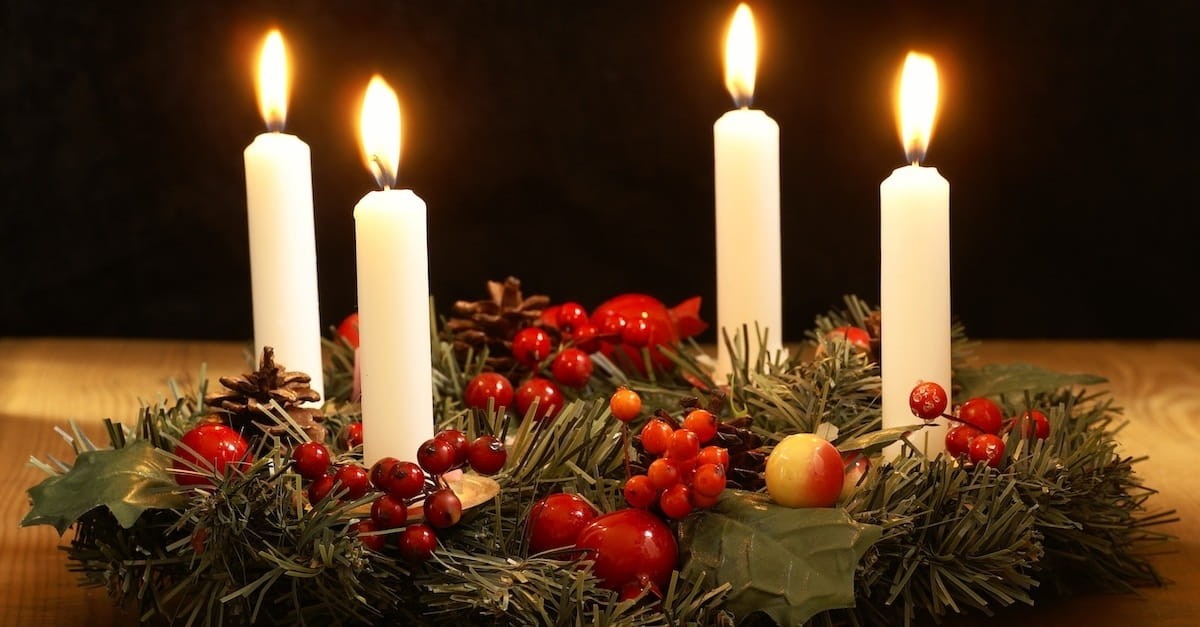
In Christian churches, where a candle is often lit each of the four Sundays before December 25th. Besides candles, many homes feature wreaths on their front doors or adorning their dinner tables, possibly incorporating candles. There is meaning behind the Christmas season, which begins with the celebration of Advent. These traditions: what is the symbolism behind Advent candles and wreaths? Firstly, what is Advent? This is a season of waiting. We try to imagine what it was like for Mary and Joseph to wait for the birth of Immanuel and how the Jews waited for their Savior for centuries before he was born. We also anticipate Christ’s return. How do the following five symbols fit with Advent and also connect with the Gospel overall?
Photo Credit: ©Unsplash/ Kelly Sikkema

1. Why Are Candles a Symbol of Advent?
Kor Adana explains the history and meaning of Advent candles, dating back around two centuries to a German tradition marking the four weeks prior to Christmas. According to Adana, this is a German tradition that started with just one candle lit on December 5th, a candle large enough to remain burning throughout the days of Advent as a symbol of “the light of Christ shining in the darkness of the world.” Other experts have weighed in, dating the custom to earlier generations and other countries, but always with that same core theme: light in the darkness.
In the beginning, families lit their own candles every Sunday for those four weeks. Eventually, churches started to observe this custom. Sometimes, young families are invited to get involved with lighting the candles in church, taking turns reading from Scripture before one member of the family lights the candle for that Sunday.
While 21st-century Christians can usually flick a switch at any time and light a room, this was not the case two hundred (even one hundred) years ago. Darkness, especially for those countries where December is winter time, experienced darkness in a way we cannot truly relate to in our modern world, especially in cities and small towns littered with light pollution. We can, however, relate to spiritual darkness since we can see this any time we turn on the news or even recognize our own sin. Candles at Advent remind us that Jesus is the “Light of the world.” (John 8:12). When he was born, the elderly Simeon declared Jesus to be the one he was waiting for, Israel’s “consolation” (Luke 2:25), “a light for revelation to the Gentiles, and for glory to your people Israel.” (2:32)
Photo Credit:
©Unsplash/KaLisa Veer

2. Why Is There an Order to Light the Advent Candles?
Each candle stands for “a different aspect of the spiritual journey towards the birth of Jesus Christ. The progression of lighting a new candle each week serves as a visual representation of the increasing anticipation and illumination as Christmas draws near,” says Adana. Advent candles remind us of the hope we have in Jesus, for an eternal future with him in his kingdom where “the city has no need of sun or moon to shine on it, for the glory of God gives it light, and its lamp is the Lamb.” (Revelation 21:23)
Within the church, the first Advent candle is typically lit on the last Sunday in November, and this one stands for “hope.” The following Sunday, two are lit, the second representing “peace.” The angels declared, “Glory to God in the highest! And on earth, peace among those with whom he is pleased!” (Luke 2:14) The faithful will know peace with God. Third is “joy”, then “love”.
A church leader might read an Advent poem, Scripture, or both, highlighting that day’s theme of hope, joy, peace, or love. Within the home, many families do the same thing privately, reading about Mary’s encounter with the Angel Gabriel, the Shepherd, and the host of angels singing, the angel reassuring Joseph, and then the long journey to Bethlehem. Lastly, on Christmas day (or Christmas Eve in some homes), the white Christ light would be lit.
There is more to the lighting of candles than just picking one and striking a match. Writers on the subject indicate that there can be specific colors: three are purple, and there is a pink one to symbolize “joy,” standing vibrantly apart from the others, as does any joyful person filled with the Holy Spirit. And, finally, a “Christ candle” is always white.
However, colored candles are not standard; many churches and homes also stick with simple white candles, and a Christ Candle is not always incorporated. Still, other homes have gone completely rogue and chosen four individual colors, plus the white Christ candle.
There is no reason to adhere to a man-made tradition; nothing Biblical directs us towards any of these practices, so if you want to use whatever candles you already have, do that. The point is that lighting the candles inspires you to think of the Light of the World and his remarkable, salvific story. Read the real Scriptures, tell the true story, and come back to Immanuel every December.
Avoid being superstitious about candle colors and sizes because God is not displeased with brown, green, or yellow. Worrying about colors should be a red flag that you are too concerned with a method of worship and less interested in the focus of your worship, which is Christ.
Photo Credit: iStock/Getty Images/Kara Gebhardt

3. Why Is the Wreath a Symbol of Advent?
One writer explains that the wreath is “a circular garland made of evergreen branches [which] symbolizes eternity; Its circular shape represents God’s eternal life and love.” A circle never ends. Evergreens appear never to die. Both of these features of a garland emphasize the eternal nature of the Triune God, which is why this centerpiece is made from fir and not from some other plant (or an artificial facsimile).
Advent candles are frequently arranged on a table inside this circle of greenery. Today’s advent wreaths are frequently wired with electrical candles and plugged into a socket or are battery-powered to provide a safe, cool source of light that will not cause a fire. Some of them are made from plastic, although the real thing smells good. What God finds especially pleasing, however, is the way a family gathers lovingly around the table where the Advent wreath and candles are featured. “And walk in love, as Christ loved us and gave himself up for us, a fragrant offering and sacrifice to God. (Ephesians 5:2)
Putting the two themes of light and eternity together is natural and aesthetically pleasing in a traditional way, although there are so many styles of wreaths today that some are far removed from the symbolism of Christ’s eternal nature and his irrepressible light. A lot of craft-related imagery online overcomplicates the motif with bows, bells, beads, flowers, and feathers. Non-traditional wreaths can still point to Christ if the family represents Jesus to each other and to guests, just as the wreath alone is not a symbol of Christ in a home where there is no peace, joy, hope, or love in evidence.
Many churches and homes today opt for an alternative to the wreath: they dislike plastic but prefer not to bring in real foliage. Or they want real candles and are concerned about either plastic or real fir needles catching fire. Instead, you can find candle holders designed for Advent, including candelabras, simple wooden trays featuring candle-shaped grooves, or ceramic items with candle holders at different heights and engraved with Bible verses and the words “joy,” “hope,” “love,,” and “peace.”
Photo Credit: ©GettyImages/MKucova

4. Why Are Red Berries Symbolic during Advent?
In the current generation, wreaths come in all shapes and designs. Secular homes are decorated to represent the people inside the home, not to symbolize faith in Christ. The purpose of a Christmas wreath in the Christian tradition, however, is to point to the ultimate purpose of Christ’s coming: to die on the cross. Red berries represent the blood of Christ.
Yellow berries will not work the same way, nor will action figures, pink roses, or blue plaid ribbons. Wreaths CAN be fashion statements, but the individual who wonders what all of that tradition is about might be astonished to know that there is a point to the old-fashioned red-dotted wreath.
A simple touch of red to the rich green of an Advent wreath reminds us that Christ’s birth was part of his sacrifice, leaving his throne and coming to earth to die. As the Gospel of Matthew describes: “And twisting together a crown of thorns, they put it on his head and put a reed in his right hand. And kneeling before him, they mocked him, saying, ‘Hail, King of the Jews!’” (Matthew 27:29)
We often make the mistake of believing “simple” means “old-fashioned” and that previous generations lacked the resources or creativity to do something different. Where wreaths are concerned, modern design could be a purposeful distraction from the distressing progression from Christ’s birth to the cross. Christians often want the baby but not the blood.
Photo Credit: Getty/Margarita Khamidulina

5. Why Do We Hang a Wreath on Our Door during Advent?
If it seems cruel to weave the cross into Christmas, then the introduction of door wreaths during this season points to the ultimate victory of Christ’s life on earth. His story starts in a manger but does not end at the cross.
Although door wreaths have their origins in ancient times, these decorative items have been incorporated meaningfully into the Advent tradition. One wreath enthusiast explains: “In ancient Greece and Rome, wreaths were associated with victory and achievement. They were crafted from various foliage, such as laurel leaves, and were often worn as crowns during special ceremonies and athletic competitions. These wreaths symbolized honor, success, and social status.”
When a wreath is incorporated into Christian observance, including Advent, this symbolism is redeemed for the gospel. That crown of thorns becomes Victor’s crown worn by the King of Kings. At Christmas, we can declare with Paul, “Thanks be to God, who in Christ always leads us in triumphal procession, and through us spreads the fragrance of the knowledge of him everywhere.” (2 Corinthians 2:14) And with him in us by his Holy Spirit, we hope to say one day “I have finished the race, I have kept the faith. Henceforth, there is laid up for me the crown of righteousness, which the Lord, the righteous judge, will award to me on that day, and not only to me but also to all who have loved his appearing.” (2 Timothy 4:7-8) Advent leads to a Baby; the Baby leads us to salvation and to victory over winter, over darkness - and over death.
Wreaths and candles are visual conversation points. It is easy to break the ice with guests visiting your home with chit-chat about decor. A neutral, non-religious subject like “Christmas decorations” can be a natural way to lead into a discussion of the gospel. But tradition can become religious if we just do things because we always have, without understanding why. Question your decorative choices and ask if they serve your worship.
Sources: https://christian.net/special-themes/what-is-the-order-for-the-advent-candles/#:~:text=The%20order%20in%20which%20the%20Advent%20candles%20are%20lit,%20along
https://guideposts.org/inspiring-stories/advent-symbols-what-do-they-mean/#:~:text=Celebrate%20the%20season%20and%20create%20traditions%20of%20your%20own%20with
https://www.thedoorwreaths.com/blog/author/wreath-enthusiast/page/2/#:~:text=In%20ancient%20Greece%20and%20Rome,%20wreaths%20were%20associated%20with
https://www.biblestudytools.com/bible-study/topical-studies/what-is-advent-wreath.html#:~:text=Evergreen%20Branches:%20Typically%20made%20from%20evergreen%20branches,%20the
Photo Credit: ©Unsplash/Annie Spratt

Originally published Wednesday, 30 October 2024.
